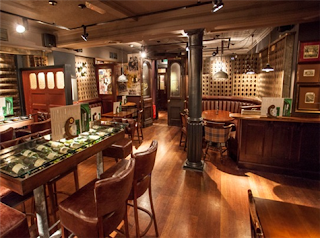Medieval Courts & Alleys off Cornhill and Lombard Street
On this lovely bright, sunny day, myself and my E.A.A.C., who, after consultation, does not actually mind being known by her real name; Deborah, strolled merrily along to our next bunch of destinations. Yes, today will consist of a plethora of interesting sights. Today there was no need to jump in a taxi or on the tube as today's sights are right on our doorstep. How cool. Getting away from your desk at lunch, if you work in an office, is a necessity. If you are one of these people who refuses to do this, please re-evaluate your priorities and get out and blow the cobwebs off! We recommend it!!
So first stop, the 'Charity Drinking Fountain' (also known as La Maternité, or 'Maternal Love') by Aimé-Jules Dalou. (1877-79). It's a bronze sculpture (a replacement of the marble original) with a fountain structure beneath a mixture of grey and pink granite. Lovely sculpture and interesting to see the old rings on the drinking fountain where the fountain cups would have been fastened by a chain.
From here we ventured along Cornhill, to a Water Pump alongside the Royal Exchange. Before the introduction of the mains supply in London, the pumps were a defining element of the city, public water sources that permitted settlement and provided a social focus in each parish. Now, where they remain, they are redundant relics unused for generations, either tolerated for their picturesque qualities or ignored by those heedless of their existence.
The text on the pump reads, “On this spot a well was first made and a house of correction built thereon by Henry Wallis Mayor of London in the year 1282.” Designed by architect Nathaniel Wright and erected in 1799. It's probably one of these things you'd never notice as you walked by.
We have started to become less aware of the stares and attention we have been getting as we photograph strange objects in the middle of busy London streets!
Anyway, we then headed in the direction of Lombard Street to check out an interesting Grade II listed building there. As we turned down a tiny alley, we emerged to see the building in its full glory. 24-28 Lombard Street used to be the the Royal Insurance Building, not sure what it is now, but either way, the sculptures above the doorway are impressive. Check out the bronze sculpture by F. W. Doyle-Jones (1914), it depicts the power of the sea, fire and a semi sphinx with wings in the centre representing the uncertainty of the future.
From here we ventured through the winding alleys off Lombard Street and saw some interesting sights along the way, including the George & Vulture, an ancient public house mentioned by Dickens.
Weary pilgrims that we were, we realised we needed some refreshment and a little rest, so we headed for the Jamaica Wine House, tucked away in St. Michael’s Alley. The Jamaica Wine House was originally London’s first coffee house, which opened in 1652 and counted Samuel Pepys among its earliest patrons. Jamaica Wine House has historic links with the sugar trade and slave plantations of the West Indies and Turkey. There is a plaque on the wall which reads 'Here stood the first London Coffee house at the sign of the Pasqual Rosee's Head 1652.' Pasqua Rosée, the proprietor was the servant of a Levant Company merchant named Daniel Edwards, a trader in Turkish goods, who imported the coffee and assisted Rosée in setting up the establishment. The coffee house, which opened in 1652, is known in some accounts as The Turk's Head.
(this photo only is borrowed from: http://www.jamaicawinehouse.co.uk/, as we didn't actually take a photo inside)
After watering ourselves, we headed back to our desks, satisfied in the knowledge that we had once again, explored another hidden part of this fascinating City.
Join us next week for the next instalment! Deborah has now become co-author of this blog, and will thrill you with the next adventure!
















Fantastic Jess! My old dad would be as proud as punch.
ReplyDeleteDadxxx